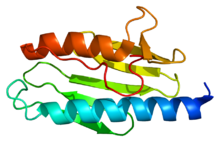
Back رنح فريدريخ Arabic Friedreichova ataksija BS Atàxia de Friedreich Catalan Friedreichova ataxie Czech Friedreich-Ataxie German Αταξία Φρίντριχ Greek Ataxia de Friedreich Spanish آتاکسی فردریش Persian Friedreichin ataksia Finnish Ataxie de Friedreich French
| Friedreich's ataxia | |
|---|---|
| Other names | Spinocerebellar ataxia, FRDA, FA |
 | |
| Frataxin | |
| Specialty | Neurology |
| Symptoms | Lack of coordination, balance issues, gait abnormality |
| Complications | Cardiomyopathy, scoliosis, diabetes |
| Usual onset | 5–20 years |
| Duration | Long-term |
| Causes | Genetic |
| Diagnostic method | Medical history and physical examination |
| Treatment | None |
| Prognosis | Shortened life expectancy |
| Frequency | 1 in 50,000 (United States) |
Friedreich's ataxia (FRDA or FA) is an autosomal-recessive genetic disease that causes difficulty walking, a loss of coordination in the arms and legs, and impaired speech that worsens over time. Symptoms generally start between 5 and 20 years of age. Many develop hypertrophic cardiomyopathy and require a mobility aid such as a cane, walker, or wheelchair in their teens. As the disease progresses, some affected people lose their sight and hearing. Other complications may include scoliosis and diabetes.
The condition is caused by mutations in the FXN gene on chromosome 9, which makes a protein called frataxin. In FRDA, cells produce less frataxin. Degeneration of nerve tissue in the spinal cord causes the ataxia; particularly affected are the sensory neurons essential for directing muscle movement of the arms and legs through connections with the cerebellum. The spinal cord becomes thinner, and nerve cells lose some myelin sheath.
In February 2023, the first approval of a treatment for FRDA, omaveloxolone, was granted by the US Food and Drug Administration (FDA). Approval in the European Union was granted in February 2024.
FRDA affects one in 50,000 people in the United States and is the most common inherited ataxia.[not verified in body] Rates are highest in people of Western European descent.[not verified in body] The condition is named after German physician Nikolaus Friedreich, who first described it in the 1860s.
© MMXXIII Rich X Search. We shall prevail. All rights reserved. Rich X Search